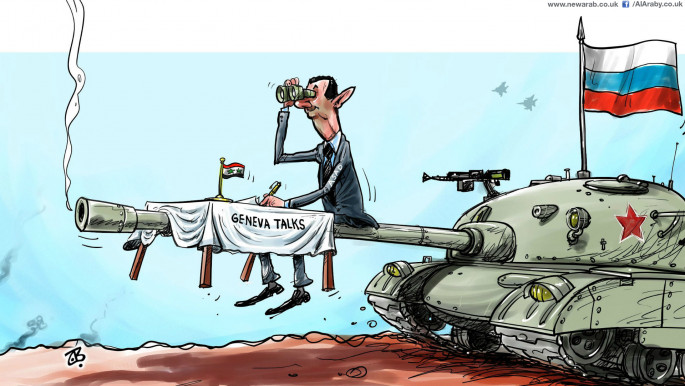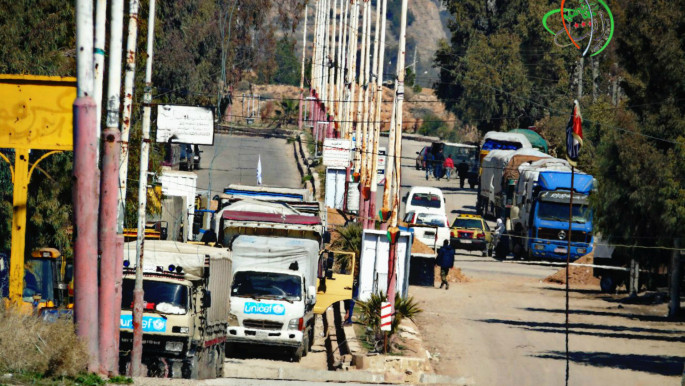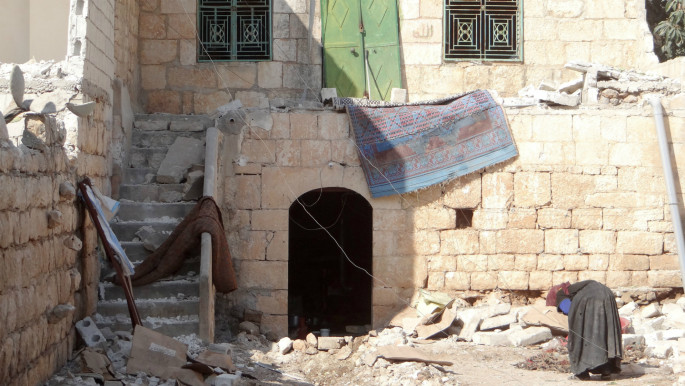Views from a subdued Syria
While some regions of the war-ravaged country have enjoyed a quieter weekend amid a ceasefire, many are are less optimistic, waiting a return of regime bombardment.
7 min read
Syrian children play on a swing at a park in the town of Douma [Getty]
"People are starting to feel relatively safe," said journalist Ahmed al-Akla, describing civilians in Idlib, northwest Syria, on the second day of the "truce" between Syrian armed opposition fighters and regime forces and their allies.
Akla said that normal life had briefly returned in various cities, towns and villages in the countryside here - often dubbed the heartland of the revolution; an area which has survived a particularly heavy onslaught from the regime.
Shoppers have begun to return to the markets of Kafr Nabal, he added.
Journalist Heshem Abdullah, located on the Syrian-Turkish border, said that the truce "has not been unable to dispel fears of a resumption of bombings… scenes of massacres committed by the regime air force and Russian jets are still fresh in the mind".
Khalid al-Khalaf, a local activist, said that everyday life was also returning to Saraqeb, east of Idlib, on the highway that connects Damascus and Aleppo.
"Saraqeb, which used to be bombed almost daily, was starting to experience normal life gradually," Khalaf told The New Arab. "The displaced are returning to their homes in areas which they consider no longer dangerous.
"Families are no longer looking to leave to the countryside during the day to escape the shelling of the city before returning to their homes again at night," he added.
"People have started going to the city markets since the ceasefire started."
In recent weeks, Aleppo has suffered a particularly heavy onslaught by the regime, who have encroached upon the city causing the displacement of hundreds of thousands of people.
Ammar al-Bakour said that a sense of caution prevails, although the civilians still fear the return of bombing.
"There is a lack of trust among a large number of civilians due to breaches of the truce from Russia, as in the town of Idlib and Dara Aza in the Western Aleppo countryside," he said. "A state of fear controls civilians."
Yet while many report small improvements with regard to bombing, residents still suffer from a lack of basic supplies and services.
"The general situation in the city has improved with this truce," 60-year-old Abu Nidal told AFP in Maghayir, a rebel-held neighbourhood in the east of Aleppo. "Everything is available to us - except water."
At least 20 people were killed in Syria on Saturday, the first day of the truce, in areas where the Islamic State group is not present, the Syrian Observatory for Human Rights said.
The same number of people were killed on Sunday, said UK-based Observatory chief Rami Abdel Rahman.
"To compare, 144 were killed - 70 soldiers, 36 civilians, and 38 rebels - on Friday, on the eve of the truce," Abdel Rahman told AFP.
The average daily death toll for February was 120, he added.
The complex truce deal does not apply to areas controlled by the Islamic State group or the Nusra Front, where airstrikes and ground fighting have continued.
Many had been pessimistic about any ceasefire, after Russia revealed it would include only tiny parts of Syria in its cessation of hostilities.
They had defined large swathes of rebel-held areas as territory held by the al-Qaeda affiliated Nusra Front, which were therefore eligible to bomb.
The Nusra Front, meanwhile, has reportedly withdrawn from civilian areas in a purported attempt not to give Russia an excuse to target residential towns - although Syria's al-Qaeda franchise has not formally recognised the truce.
Although the Syrian coalition has already counted 26 truce violations, analysts have also said that sustaining a temporary ceasefire may also be in the interests of both Damascus and Moscow in order to consolidate recent regime gains, and to put a halt to fighting in areas where the opposition was putting up an especially tough fight.
Some rebels of Aleppo suspect that the ceasefire is in fact "a trick" by the regime and its allies in order to hold more territory.
Accordingly, the ceasefire has been met with mixed views across Syria; while many appreciate a temporary lull in continuous bombardment, residents are aware that the respite is likely to be just that; temporary.
Damascus countryside
Many in the city of Moadamiyeh have recently expressed a sense of security following months of incessant shelling by aviation and artillery.
The city was the scene of intense fighting between Free Syrian Army factions and Fourth Division troops - which have a reputation for being a particularly brutal section of the regime's army, and attempted to enter the city following its separation from its neighbour, Daraya.
"The situation has improved in Moadamiyeh in terms of availability of food, although the city is still under siege and no one comes out or enters the city. The markets are closed as there are no goods for sale," media activist Dani Qappani told The New Arab.
Although Qappani said that "there is a good movement of civilians in the streets after the truce took effect", many have been unable to reach their homes in the south of the city, much of which remains in the crosshairs of regime snipers.
On the first day of the truce, one young man returning home was shot by a marksman in a southern neighbourhood. He is now in a stable condition.
Generally, bombardment has eased in towns south of Damascus, many of which signed reconciliation deals while being held under regime siege before the recent truce took effect.
On Monday aid was permitted to enter Moadamiyeh, and other areas that have come to reconcilliation deals are reportedly meeting with Red Crescent officials to arrange more aid drops.
But in the besieged city of Tel Menen, north of Damascus, the view differs.
"Nothing has changed, except the decline in air traffic over the city after the truce took effect," said activist Ahmed Bauanuni.
"Our situation in the city after the truce is the same as it was before. We are still trapped by regime checkpoints that prevent the entry of food, medical supplies, fuel and flour to the city, while civilians continue to be arrested at the checkpoints, especially young people," he said.
"Those trapped want to break the siege on the city once and for all. The introduction of humanitarian aid for a short period is not enough."
Homs and Hama
In the central province of Hama, jet fighters continued to carry out repeated attacks on the village of Harebnafsah, amid fighting between troops and militants, according to the Syrian Observatory for Human Rights and the Local Coordination Committees, both opposition-leaning monitoring groups.
The LCC said the warplanes were Russian. It was not immediately clear which militant groups were taking part in the fighting on the ground.
Ahmed Abu Mohammed told The New Arab that the area was the target of 16 air raids, and hundreds of mortar shells and rockets as the regime attempted to make progress in the area.
"The ceasefire agreement did not reflect positively on the lives of people across the Houla Valley, as civilians were hoping for better than a truce, especially on a humanitarian level. There is a scarcity of food and people feel threatened."
North Hama has been almost completely destroyed during the five years of the uprising, however some movement has now returned to some cities and towns, according to activist Shahoud Jadou.
He told The New Arab that civilians remain cautious to leave their homes, since many planes continue to circle ominously overhead.
"We are not completely at ease here, as the majority of the inhabitants of north Hama, in Lataminah and Kafr Zita, are excluded from the truce, according to the maps that highlighted the areas covered by the ceasefire deal," he said.
In the town of Talbiseh, north of Homs, the ceasefire was preceded by a barrage of strikes.
"Just a few hours before the truce, the Russian aircraft bombed Talbiseh with more than 16 airstrikes," local activist Firas Said wrote on Facebook.
"Martyrs' families are under wreckage, only cries of children, the sounds of warplanes and explosions are being heard everywhere."
Many fear that these will be the scenes that will quickly return to Syria once the two week ceasefire is over.
Reporting from Amin Mohammed. Additional reporting from Imogen Lambert.
Akla said that normal life had briefly returned in various cities, towns and villages in the countryside here - often dubbed the heartland of the revolution; an area which has survived a particularly heavy onslaught from the regime.
Shoppers have begun to return to the markets of Kafr Nabal, he added.
Journalist Heshem Abdullah, located on the Syrian-Turkish border, said that the truce "has not been unable to dispel fears of a resumption of bombings… scenes of massacres committed by the regime air force and Russian jets are still fresh in the mind".
Khalid al-Khalaf, a local activist, said that everyday life was also returning to Saraqeb, east of Idlib, on the highway that connects Damascus and Aleppo.
"Saraqeb, which used to be bombed almost daily, was starting to experience normal life gradually," Khalaf told The New Arab. "The displaced are returning to their homes in areas which they consider no longer dangerous.
"Families are no longer looking to leave to the countryside during the day to escape the shelling of the city before returning to their homes again at night," he added.
"People have started going to the city markets since the ceasefire started."
In recent weeks, Aleppo has suffered a particularly heavy onslaught by the regime, who have encroached upon the city causing the displacement of hundreds of thousands of people.
Ammar al-Bakour said that a sense of caution prevails, although the civilians still fear the return of bombing.
"There is a lack of trust among a large number of civilians due to breaches of the truce from Russia, as in the town of Idlib and Dara Aza in the Western Aleppo countryside," he said. "A state of fear controls civilians."
 |
Families are no longer looking to leave to the countryside during the day to escape the shelling of the city before returning to their homes again at night |  |
"The general situation in the city has improved with this truce," 60-year-old Abu Nidal told AFP in Maghayir, a rebel-held neighbourhood in the east of Aleppo. "Everything is available to us - except water."
At least 20 people were killed in Syria on Saturday, the first day of the truce, in areas where the Islamic State group is not present, the Syrian Observatory for Human Rights said.
The same number of people were killed on Sunday, said UK-based Observatory chief Rami Abdel Rahman.
"To compare, 144 were killed - 70 soldiers, 36 civilians, and 38 rebels - on Friday, on the eve of the truce," Abdel Rahman told AFP.
The average daily death toll for February was 120, he added.
The complex truce deal does not apply to areas controlled by the Islamic State group or the Nusra Front, where airstrikes and ground fighting have continued.
Many had been pessimistic about any ceasefire, after Russia revealed it would include only tiny parts of Syria in its cessation of hostilities.
They had defined large swathes of rebel-held areas as territory held by the al-Qaeda affiliated Nusra Front, which were therefore eligible to bomb.
 |
|
Although the Syrian coalition has already counted 26 truce violations, analysts have also said that sustaining a temporary ceasefire may also be in the interests of both Damascus and Moscow in order to consolidate recent regime gains, and to put a halt to fighting in areas where the opposition was putting up an especially tough fight.
Some rebels of Aleppo suspect that the ceasefire is in fact "a trick" by the regime and its allies in order to hold more territory.
Accordingly, the ceasefire has been met with mixed views across Syria; while many appreciate a temporary lull in continuous bombardment, residents are aware that the respite is likely to be just that; temporary.
Damascus countryside
 |
Our situation in the city after the truce is the same as it was before |  |
The city was the scene of intense fighting between Free Syrian Army factions and Fourth Division troops - which have a reputation for being a particularly brutal section of the regime's army, and attempted to enter the city following its separation from its neighbour, Daraya.
"The situation has improved in Moadamiyeh in terms of availability of food, although the city is still under siege and no one comes out or enters the city. The markets are closed as there are no goods for sale," media activist Dani Qappani told The New Arab.
Although Qappani said that "there is a good movement of civilians in the streets after the truce took effect", many have been unable to reach their homes in the south of the city, much of which remains in the crosshairs of regime snipers.
On the first day of the truce, one young man returning home was shot by a marksman in a southern neighbourhood. He is now in a stable condition.
Generally, bombardment has eased in towns south of Damascus, many of which signed reconciliation deals while being held under regime siege before the recent truce took effect.
 |
|
| Aid entered Moadamiyeh past regime checkpoints on Monday [Twitter] |
But in the besieged city of Tel Menen, north of Damascus, the view differs.
"Nothing has changed, except the decline in air traffic over the city after the truce took effect," said activist Ahmed Bauanuni.
"Our situation in the city after the truce is the same as it was before. We are still trapped by regime checkpoints that prevent the entry of food, medical supplies, fuel and flour to the city, while civilians continue to be arrested at the checkpoints, especially young people," he said.
"Those trapped want to break the siege on the city once and for all. The introduction of humanitarian aid for a short period is not enough."
Homs and Hama
In the central province of Hama, jet fighters continued to carry out repeated attacks on the village of Harebnafsah, amid fighting between troops and militants, according to the Syrian Observatory for Human Rights and the Local Coordination Committees, both opposition-leaning monitoring groups.
The LCC said the warplanes were Russian. It was not immediately clear which militant groups were taking part in the fighting on the ground.
Ahmed Abu Mohammed told The New Arab that the area was the target of 16 air raids, and hundreds of mortar shells and rockets as the regime attempted to make progress in the area.
"The ceasefire agreement did not reflect positively on the lives of people across the Houla Valley, as civilians were hoping for better than a truce, especially on a humanitarian level. There is a scarcity of food and people feel threatened."
 |
|
| The aftermath of an alleged ceasefire violation in Aleppo [Anadolu] |
He told The New Arab that civilians remain cautious to leave their homes, since many planes continue to circle ominously overhead.
"We are not completely at ease here, as the majority of the inhabitants of north Hama, in Lataminah and Kafr Zita, are excluded from the truce, according to the maps that highlighted the areas covered by the ceasefire deal," he said.
In the town of Talbiseh, north of Homs, the ceasefire was preceded by a barrage of strikes.
"Just a few hours before the truce, the Russian aircraft bombed Talbiseh with more than 16 airstrikes," local activist Firas Said wrote on Facebook.
"Martyrs' families are under wreckage, only cries of children, the sounds of warplanes and explosions are being heard everywhere."
Many fear that these will be the scenes that will quickly return to Syria once the two week ceasefire is over.
Reporting from Amin Mohammed. Additional reporting from Imogen Lambert.





 Follow the Middle East's top stories in English at The New Arab on Google News
Follow the Middle East's top stories in English at The New Arab on Google News


